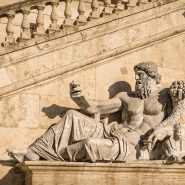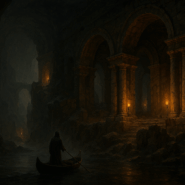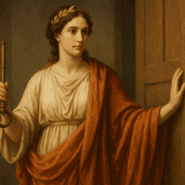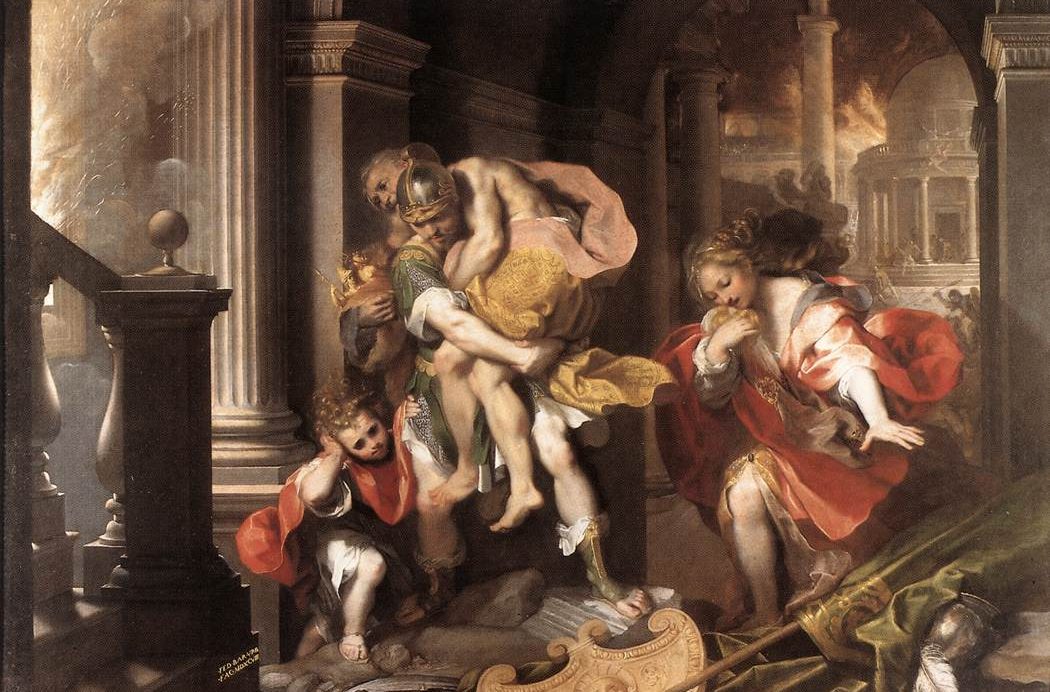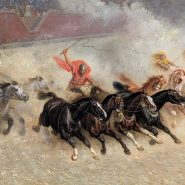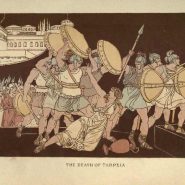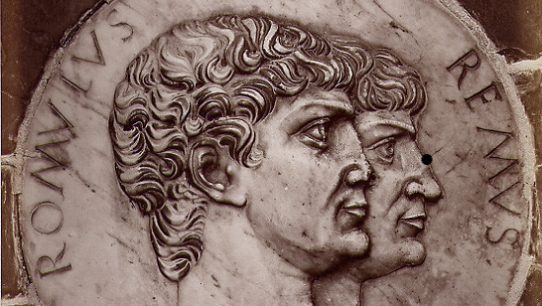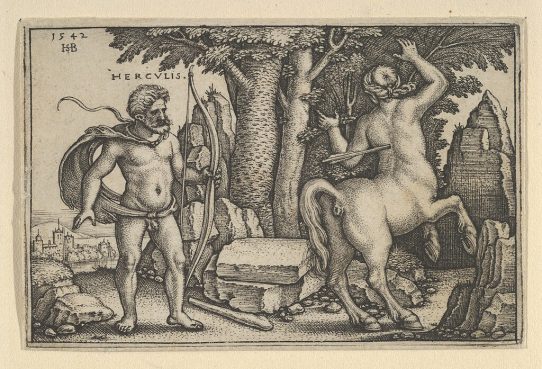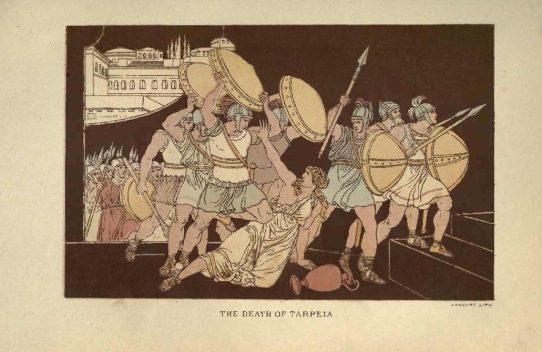Aeneas is the bridge between fallen Troy and the rising destiny of Rome. His story is the Roman answer to the question of origins. Out of ash and exile, he carries a father, a son, and a covenant with the gods. The journey moves from catastrophe to calling, from private grief to public duty.
In Virgil’s telling, the trials of sea and soul form a single education in pietas — the Roman virtue of devotion to family, gods, and the future state.
Characters and Setting
Aeneas is the son of the mortal Anchises and the goddess Venus. When Troy falls to the Greeks, he flees the flames with his father on his back and his young son Ascanius by his side. He gathers refugees and launches a fleet with a single aim: to reach the land promised by prophecy, where his line will found a people and give laws to the world.
Watching from above are Jupiter, who steers the long arc of fate, and Juno, who opposes Aeneas because Rome will one day overshadow Carthage, her beloved city.
After Troy: Loss and Leaving
Night collapses Troy. Aeneas fights in vain, then obeys a higher command to save what can be saved. His wife, Creusa, is lost in the chaos. Her shade appears and urges him to live for a future beyond grief.
At dawn, he leads survivors to the shore. With the city behind them and the sea ahead, duty becomes a voyage, and hope becomes a map written in omens.
Winds, Oracles, and Islands
The exiles probe the Mediterranean for a homeland. At Thrace, they encounter a bloodied omen that forbids settlement. On Delos, they receive Apollo’s cryptic counsel. At Crete, a pestilence drives them away. Harpies curse them with hunger.
In Epirus, they find a Trojan remnant under Helenus and Andromache, who offer prophecies and sailing routes. Every island is a lesson; every storm, a test of leadership. Aeneas holds his people together by promise and example. He weathers tempests stirred by Juno, who recruits Aeolus to lash the seas. Neptune calms the waters, and the voyage continues.
Carthage and the Queen
Shipwrecked by another storm, Aeneas washes ashore in Libya. There he meets Queen Dido, who has carved a thriving city from exile and pain. Venus, anxious for her son’s safety, kindles love between them. Aeneas narrates the fall of Troy and the wanderings that followed. Dido’s sympathy becomes desire.
For a time, duty yields to sweetness, and the city becomes a refuge. Yet winter cannot become a home. Jupiter sends Mercury with a message that cannot be ignored. The hero must leave. Aeneas chooses obedience over passion. Dido breaks under the decision and dies by her own hand, cursing the future enmity between Carthage and Rome.
Sicily and the Funeral Games
In Sicily, they honor the memory of Anchises with funeral games. The living test their skill in rowing, racing, boxing, and archery. The contests tighten bonds that grief had frayed. But Juno sows unrest among the Trojan women, who burn the ships in despair.
Rain quenches the flames, and Aeneas sends the weary to settle in Sicily while the hardened continue toward destiny. The mission is clarified by loss. Those who proceed understand that the journey is a vow, not a whim.
The Descent to the Underworld
In Italy, Aeneas seeks the Sibyl of Cumae. Guided by prophecy and carrying the golden bough, he descends to the underworld.
There he encounters shades that mirror the costs of choice. He meets Dido, who turns away in silence. He speaks with his father, Anchises, who reveals a pageant of Roman souls yet unborn.
A river of light flows with names that will someday shape the world. Anchises shows him the destiny of the Julian line and the coming of Augustus. This vision binds private duty to public future. Aeneas returns to the living with a changed heart. He no longer wanders. He advances.
War in Latium
Latium holds promise and peril. King Latinus offers land and the hand of his daughter, Lavinia. Juno inflames the local prince, Turnus, and rouses Italy to war. The Trojans forge alliances. Evander, king on the future site of Rome, gives counsel and men.
Aeneas receives divine armor from Vulcan at Venus’s request. The shield shows the history of Rome that is still to come. The images are a pledge that fate is not abstraction but iron and fire in service of a city yet unborn.
Nisus and Euryalus
Among the episodes that shape the poem’s heart is the night raid of Nisus and Euryalus. Their courage bears the seal of friendship. Their deaths expose the cost of glory.
The poem honors their love and bravery, and in doing so, counsels restraint. The future does not grow from fury alone. It grows from disciplined service to a cause larger than self.
The Turn of Battle
Turnus is a noble enemy. He embodies valor without submission to destiny. The war swings on his prowess and Aeneas’s steadiness. Camilla, the Volscian maiden of speed and spear, falls in a blaze of martial beauty.
At last, the armies meet for a duel that will decide the land’s future. Juno, compelled by Jupiter’s decrees, yields. She asks only that the new people keep their Italian name and customs when Trojan blood and Latin soil become one. The pact is accepted. Fate and local identity are braided into a single civic fabric.
Climax and Mercy
Aeneas and Turnus fight. Turnus falls. He begs for life. Aeneas hesitates and almost grants mercy. Then he sees the belt of the young Pallas, slain by Turnus and stripped as a trophy. Rage returns. Aeneas strikes.
The poem ends with a hard question beneath the triumph. Roman greatness begins with victory that is just, yet bitter; necessary, yet costly. Mercy is the goal of law, but justice must sometimes be enforced before mercy can endure.
Symbolism and Interpretation
The poem traces the making of a Roman from a survivor. Pietas is the axis of the story. Piety is not sentiment. It is the trained will that bends to a divine design, even when the heart resists. Dido is the test of passion. The underworld is the test of vision. The war in Latium is the test of political responsibility. The shield is the union of art and destiny.
Aeneas succeeds not because he is invulnerable, but because he learns to align desire with duty. His greatness is obedience enlarged into leadership.
Cultural Legacy
For Romans, Aeneas explained who they were and why their empire claimed moral purpose. The poem shaped Europe’s imagination of nationhood, exile, and providence. Artists and statesmen took from it a sober hope.
The message is not a triumphal boast, but the discipline of founding. From Troy’s smoke to the Tiber’s promise, Aeneas carries a future that belongs to more than himself. That is why the story endures. It teaches that a people is built when sorrow is harnessed to law, and when love of family grows into love of country.
Gods involved: Jupiter, Juno, Venus, Neptune, Aeolus, Mercury, Apollo, Diana, Vulcan.
Based on classical sources in the public domain, including Virgil’s Aeneid and translations available via Project Gutenberg and Wikisource.
